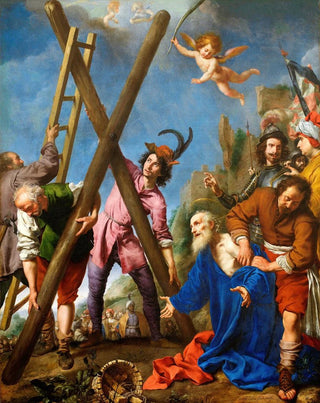Art print | Saint Andrew praying before his martyrdom - Carlo Dolci


View from behind

Frame (optional)
Saint Andrew praying before his martyrdom - Carlo Dolci – Captivating Introduction
The painting "Saint Andrew praying before his martyrdom" by Carlo Dolci is an iconic work from the 17th century that embodies the spiritual depth and technical virtuosity of its creator. In this depiction, Dolci manages to capture a moment of intense meditation, where the saint, immersed in deep reflection, prepares to face his tragic destiny. The scene, bathed in soft and warm light, invites the viewer to enter the intimacy of prayer, where every detail is meticulously crafted to evoke an atmosphere of serenity and devotion. This painting, both touching and dramatic, testifies to the artist's skill in blending emotion and technique, offering a unique visual and spiritual experience.
Style and uniqueness of the work
Carlo Dolci's style is distinguished by its finesse and delicacy, characteristics that are reflected in "Saint Andrew praying before his martyrdom". The artist uses a palette of gentle colors, dominated by warm tones that create a soothing ambiance. The drapery of the saint's garments is rendered with remarkable precision, highlighting Dolci's mastery in depicting textures. Facial expressions, imbued with melancholy and fervor, add a psychological dimension to the composition. The light, subtly orchestrated, plays a crucial role, illuminating the saint's face while casting delicate shadows that enhance the volume and depth of the scene. This approach, blending realism and spirituality, makes this work a perfect example of Florentine baroque.
The artist and his influence
Carlo Dolci, born in Florence in 1616, is one of the great masters of Italian baroque painting. Trained in a rich artistic environment, he established himself through his unique style, combining technical precision and emotional sensitivity. His works, often inspired by religious themes, reflect deep devotion and a constant pursuit of beauty. Dolci influenced many artists of his time and left a lasting mark in art history. His approach, focused on expressing feelings and depicting saints,

Matte finish

View from behind

Frame (optional)
Saint Andrew praying before his martyrdom - Carlo Dolci – Captivating Introduction
The painting "Saint Andrew praying before his martyrdom" by Carlo Dolci is an iconic work from the 17th century that embodies the spiritual depth and technical virtuosity of its creator. In this depiction, Dolci manages to capture a moment of intense meditation, where the saint, immersed in deep reflection, prepares to face his tragic destiny. The scene, bathed in soft and warm light, invites the viewer to enter the intimacy of prayer, where every detail is meticulously crafted to evoke an atmosphere of serenity and devotion. This painting, both touching and dramatic, testifies to the artist's skill in blending emotion and technique, offering a unique visual and spiritual experience.
Style and uniqueness of the work
Carlo Dolci's style is distinguished by its finesse and delicacy, characteristics that are reflected in "Saint Andrew praying before his martyrdom". The artist uses a palette of gentle colors, dominated by warm tones that create a soothing ambiance. The drapery of the saint's garments is rendered with remarkable precision, highlighting Dolci's mastery in depicting textures. Facial expressions, imbued with melancholy and fervor, add a psychological dimension to the composition. The light, subtly orchestrated, plays a crucial role, illuminating the saint's face while casting delicate shadows that enhance the volume and depth of the scene. This approach, blending realism and spirituality, makes this work a perfect example of Florentine baroque.
The artist and his influence
Carlo Dolci, born in Florence in 1616, is one of the great masters of Italian baroque painting. Trained in a rich artistic environment, he established himself through his unique style, combining technical precision and emotional sensitivity. His works, often inspired by religious themes, reflect deep devotion and a constant pursuit of beauty. Dolci influenced many artists of his time and left a lasting mark in art history. His approach, focused on expressing feelings and depicting saints,






